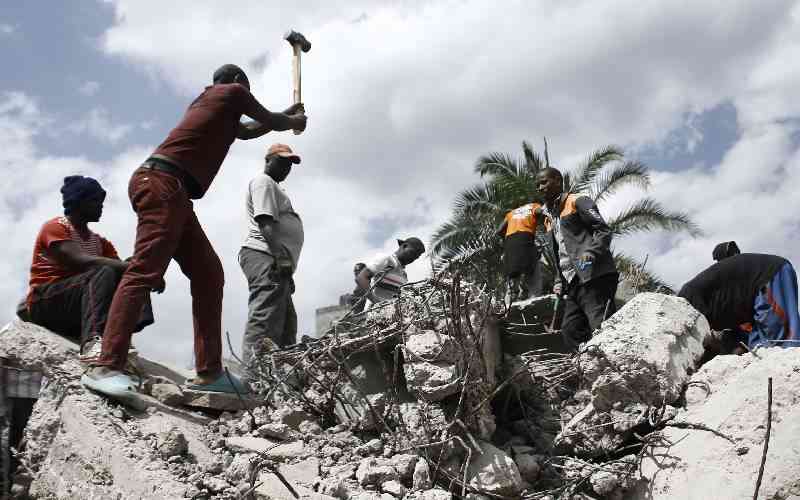By Harold Ayodo
Lydia Wairimu dreads the thought of going home every evening. She frowns every time she leaves work for home, which is on the seventh floor of a flat in Nairobi’s Donholm estate.
She stops for a breather after every two floors cursing why she never got a house on the ground floor of the residential skyscraper.
According to Wairimu, ascending to her one bedroom house is like literally climbing a mountain. She plunges into her sofa to catch her breathe for at least 15 minutes before stretching for the remote control to switch on the television.
"It is more tiring to climb the steep and narrow staircases than sitting in a traffic jam from town through Jogoo Road to the house," Wairimu says.
She settled for the house following its modest rent of Sh7,500 after the nightmare of being conned by rogue agents.
The house may be cheaper but it has turned her into a social island as most of her friends and relatives find visiting her tiring.
"I spend most weekends alone as my friends say they are not ready to drive for seven minutes from town and spend 15 minutes climbing the stairs," Wairimu says.
For Frank Basweti, shifting into his house on the sixth floor of a flat in Umoja Estate was an experience he wants to forget fast.
Cheaper option
"We used ropes to pull furniture from the ground floor to the sixth floor as the stairway is narrow and steep," Basweti says.
Interestingly, Basweti settled for the one bedroom house because of its cheaper rent compared to the same size on the ground floor.
"Rent is cheaper by Sh1,000 on the top floor compared to other floors as no tenant wants to climb the concrete mountain," Basweti says.
At Zimmerman, Paul Musyoka cannot afford to forget buying any item in his house supplies list for the day before going up to his seventh floor house, which he considers a punishment.
"Forgetting to buy an item is unthinkable… it means going back down and up seven floors , a nightmare after an 8am-5pm job in the office," Musyoka says.
Stay informed. Subscribe to our newsletter
It is worse during weekends when he goes out and thinks of the "mountain" he has to climb after having one too many.
Safety concerns
"I have resolved on few occasions to stay out till morning or spend at a friend’s… the stairway can be very unfriendly after a night out," Musyoka says.
"The situation is worse for tenants of top floors of the skyscrapers without lifts in times of water shortages.
"You either have to struggle with the 20 litre jerricans of water from the ground floor or pay an extra fee to the vendors to assist," Wairimu says.
Private developers seem to be scrambling to make hay as the Government struggles to construct the 150,000 houses annually it promised seven years ago. According to official figures, the State constructs a paltry 35,000–45,000 houses yearly, making the private developers capitalise on the shortfall of 115,000 units.
However, Housing Minister Soita Shitanda recently said his ministry had developed a Cabinet memo towards constructing more homes.
As tenants narrate their experiences on living on flats with over five floors, experts are raising concerns over their safety. Architects warn that the buildings are human death traps as more rogue developers blatantly flout construction rules.
The Kenya Private Developers Association recently raised a red flag on the fact that 80 per cent of private developers in Nairobi are not registered. Furthermore, the Architectural Association of Kenya (AAK) says any building with more that four floors must have a lift as stipulated in the Building Code.
AAK chairman Steven Oundo says most of the residential skyscrapers with five floors and above were constructed by quacks.
"Most of the buildings in Nairobi are among the 60 per cent that are not approved over wanting architectural designs," Oundo says.
AAK says areas like Dandora, Eastleigh, Kayole, Kiambu, Kasarani, Umoja, along Outerring Road and Ongata Rongai have flats that go up to eight floors.
Experts say the buildings were either not approved by the City Council or the private developers changed their plans after approval. Consequently, majority of the buildings are structurally defective and the State would save lives by pulling them down.
"No qualified architect would design such flats knowing they risk punishment by AAK over professional negligence," Oundo says.
Legally, the architects come up with building plans and forward them to the council for approval before developers get on site. Although there is a shortage of architects in Kenya, their services are also perceived as expensive. Architects charge between ten and 15 per cent of the cost of the project.
Furthermore, the local authority should give private developers an occupation certificate showing that the building is fit for human habitation. However, due to the shortage of houses and lack of knowledge, most tenants count themselves lucky to secure a house without knowing of the risks involved.
According to Oundo, the council has no capacity to approve or supervise developments to acceptable standards.
Furthermore, City Council recently admitted that it lacks the capacity to oversee the ongoing rapid development in Nairobi. Acting Director of City Planning Tom Odongo said in a meeting organised by AAK that City Hall had a paltry 20 building inspectors covering more than 680 square kilometres.
"It is impossible to serve the whole city efficiently with that number of inspectors… the technical capacity of the council needs to be improved," Odongo said.
Official figures show the country has only 120 trained planners for a population of over 38 million while the United Nations requires a planner for every 400 persons.
University of Nairobi Department of Urban and Regional Planning scholar Prof Peter Ngau says the demand for trained planners is more acute.
"The high urban growth rate is estimated at 3.9 per cent per annum with populations of over 100,000," Prof Ngau says.
He expressed the sentiments in an academic paper titled Planning System and Planning in Kenya: A Review Challenges and Prospects.
AAK insists an audit of buildings to assess their structure and safety should be done to determine those that are safe.
Interestingly, the Government exercises muscle in demolishing buildings allegedly constructed on road reserves but is tight lipped on the flats.
Government action
"We want the Government to crack down on the rogue private developers and restore sanity in the construction industry," Oundo says.
Most private developers have turned a deaf ear on fitting lifts over costs.
"It costs at least Sh3 million to install a lift… and it will still require regular maintenance just like most machines do," Oundo says.
"The buildings lack site information boards, which are a legal requirement for structures," Oundo says.
The boards on construction sites must have the names of the ongoing project, registered developer, consultant, architect and quantity surveyor. Others are the town planner, engineers (civil, structural and mechanical), landscape architect and environmental design consultants.
"Constructions without this information on the site boards are suspect and must be investigated by the local authorities," Oundo says.
According to Oundo, there are rogue private developers who erect fake site boards with names of registered professionals in the industry.
"We have informed our professionals to report instances where their names are used on the boards without their involvement," Oundo says.
Players in residential real estate demand that the Government crack the whip on rogue developers ahead of its ambition to provide more houses. For instance, the State recently introduced incentives to lower the cost of housing in the country.
 The Standard Group Plc is a
multi-media organization with investments in media platforms spanning newspaper
print operations, television, radio broadcasting, digital and online services. The
Standard Group is recognized as a leading multi-media house in Kenya with a key
influence in matters of national and international interest.
The Standard Group Plc is a
multi-media organization with investments in media platforms spanning newspaper
print operations, television, radio broadcasting, digital and online services. The
Standard Group is recognized as a leading multi-media house in Kenya with a key
influence in matters of national and international interest.
 The Standard Group Plc is a
multi-media organization with investments in media platforms spanning newspaper
print operations, television, radio broadcasting, digital and online services. The
Standard Group is recognized as a leading multi-media house in Kenya with a key
influence in matters of national and international interest.
The Standard Group Plc is a
multi-media organization with investments in media platforms spanning newspaper
print operations, television, radio broadcasting, digital and online services. The
Standard Group is recognized as a leading multi-media house in Kenya with a key
influence in matters of national and international interest.









